On the edge of Merzouga, seemingly suspended between the life of this village and the emptiness of the Sahara, lay a garden. Beyond the waist-high clay walls – built to keep the swirling sand off the crops – the desert rose up, shimmering in the blinding, mid-morning haze. The 150-metre-high dunes sizzled with heat. They looked so different to those we’d explored the previous evening, when the fine sand was rose gold and the air cooler with the promise of night.

Our camel guide in the Sahara wore the blue turban, called a tagelmust, which the semi-nomadic, desert-dwelling Tuareg people are known for.
So it goes in the Sahara, where the dunes constantly change shape and colour. In fact, most of this desert is not really dunes at all but rocky plateaus. Here where we were, in the far east of the country, it’s the archetypal desert we know from movies and paintings. The same desert that haunts the imagination and whose call you cannot deny, wherever you go in Morocco.

Built in the 14th century, Al-Attarine Madrasa is an Islamic place of learning in the middle of a spice and perfume market in Fes. It’s exquisitely decorated in the traditional patterns of Marinid craftsmanship. Image credit: Matthew Sterne
Compared to the uninviting expanse of hot sand, the desert garden seemed exotic and miraculous. And an oxymoron I could delight in, like ‘airline food’ or ‘government organisation’. It was fed by an underground canal, a khettara, that sprung four kilometres away and surfaced just outside it. Our group of five followed our guide, Abdul El Ghali, into the garden. We were greeted by twittering birds and a drop in temperature.
‘Every family in the village has a plot to grow crops on,’ Abdul said. ‘It’s the task of the naib to direct the water to each plot over the course of the day. The naib is normally an elderly man who volunteers for the job.’ The garden was dense with trees and crops, date palms rising above them all. We walked slowly, savouring the cool breeze and watching frogs jumping in and out of the canal. We saw the naib erecting clay walls to divert the water and passed alfalfa, corn, almonds, figs, apricots, peaches and sunflowers.
‘It’s like another world in here,’ enthused Patty Jones, a teacher from New York.
‘What did I tell you?’ Abdul asked. ‘Morocco is …’
‘… a country of contrasts.’ we chorused his refrain like well-drilled students.
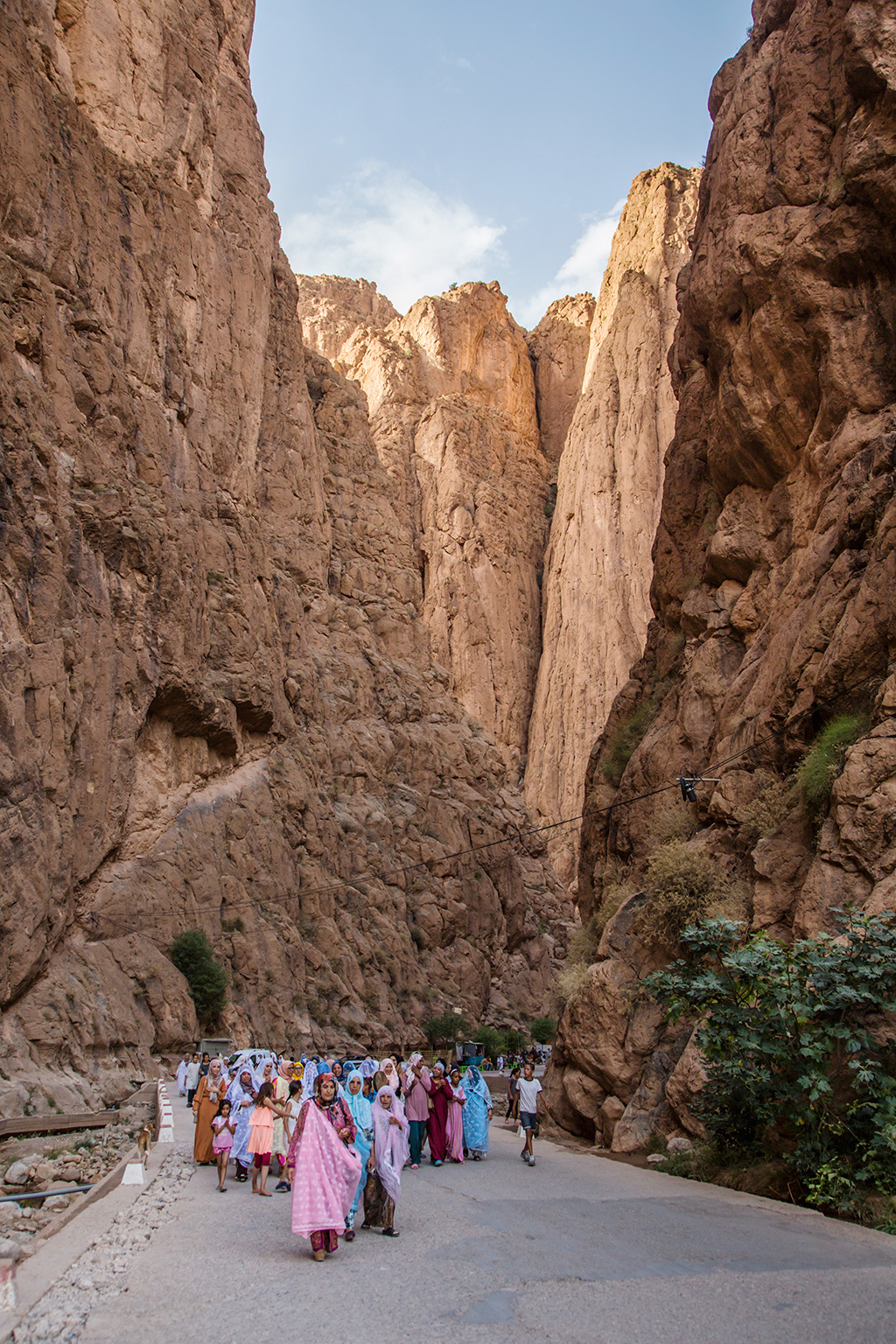
A group of women leave the coolness of Todra Gorge singing songs in anticipation of an upcoming wedding. Image credit: Matthew Sterne
We’d grown familiar with Abdul’s views on Morocco during the long drives between destinations. Our eight-day tour through this land of souks, medinas (walled cities) and hammams (traditional baths) was fast-paced, with a few hours spent on the road every day. The vehicle was bright purple and so plush it felt like the inside of a leather bag, but with air con. It could take 14 passengers, so we had more than enough space to lounge about while Abdul – a qualified lawyer and father of two in his 30s, who had a touch of Ben Affleck about him – regaled us with titbits of Moroccan life and culture.
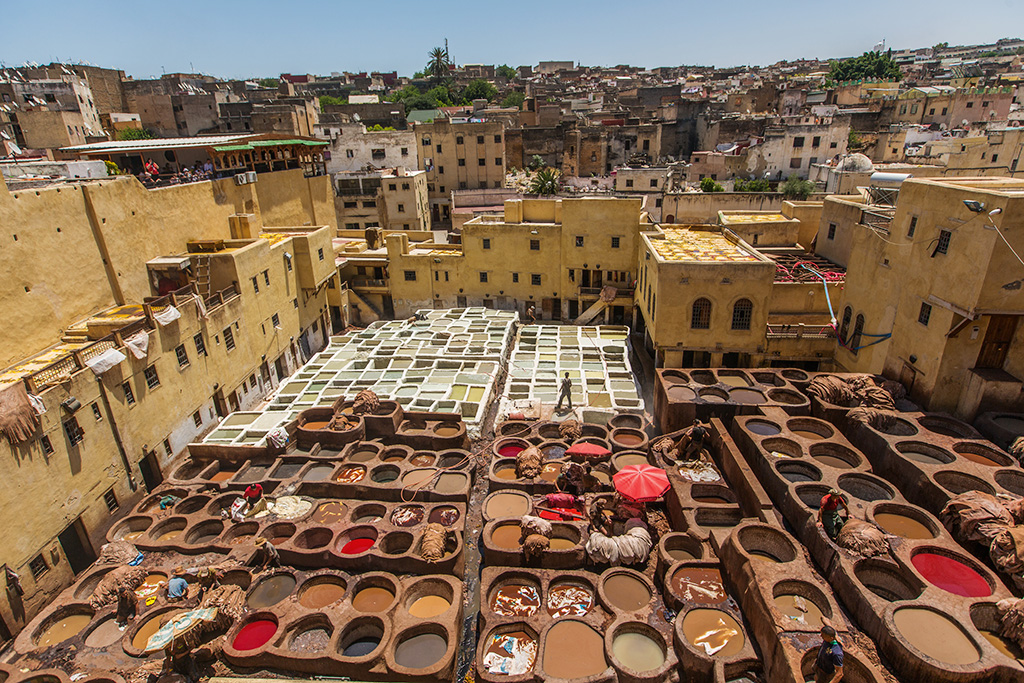
The Chouara tannery in Fes where cow, sheep and goat leather is dyed in vats, using natural agents such as tannins, pomegranate peel and poppy powder to obtain the right colours. Image credit: Matthew Sterne
Each day, he would focus on a different theme such as history, marriage, politics, religion or geography. We learnt that Morocco was known as Al Maghreb, the Land of the West, and was once considered the end of the world. As we entered the Atlas Mountains, Abdul informed us that this range divides Morocco in two, from the Atlantic in the west to Algeria in the east. North of the range it’s fairly fertile with crops of barley, wheat and olives. South you meet the Sahara. This is a country of snow and sand, oceans and mountains.

A street musician in the alleys of Marrakech. Image credit: Matthew Sterne
As we drove along the ‘Road of a Thousand Kasbahs’, we discovered that Morocco is a blend of old and new, where the distant past mingles with modern life and 1 000-year-old traditions are deeply entrenched in daily rituals. Take the communal oven, for example, where locals still meet to cook their daily bread, just as they have for centuries.
It’s one thing to be told that Fes has 9 400 alleys and is the biggest medieval medina in the world, but it’s a completely different story to step out of the van and experience the overwhelming frenzy for yourself. Fes was a dusty labyrinth of sunrays and animal smells, twisting alleys and soaring minarets. Shouts of ‘Balak! Balak!’ (Watch out! Watch out!) were followed by bustling donkeys laden with clay pots as we moved through one of the oldest inhabited Islamic cities in the world. We saw camel heads in the meat market, eels in the fish market and saffron, ‘the king of spices’, in the spice market.
Cloth dyers, loom spinners and coppersmiths lined the alleys, engaged in trades that have been passed down from father to son for generations. One of the sights was the world’s oldest university, Al Qarawiyin, founded in 859 AD, where the scholars of Islamic law were once consulted by the sultans of Morocco. Next came the notoriously smelly leather tanneries, which owe their stench to the pits of lime salt and pigeon droppings used to clean the skins. We were given mint sprigs, which we pressed to our noses to disguise the smell.
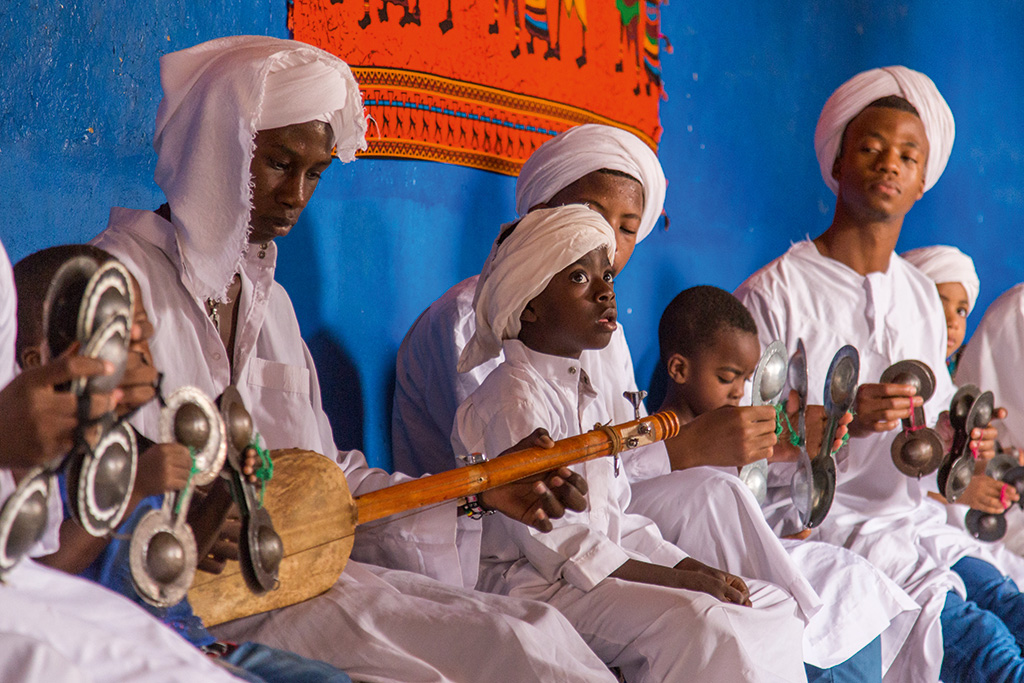
A young member of a Gnawa band gets carried off by a daydream while they play one of their ancient spiritual songs. Image credit: Matthew Sterne
That evening, I had a few hours on my own to explore the medina’s modern counterpart, Avenue Hassan II. This is where Fes comes out to play and the outward-facing, French-influenced cafes offer the best seats to take it all in. Children played in the fountains, vendors cooked corn on open grills and families sat in the green open spaces as a full moon rose at one end of the avenue. I sipped mint tea while a group of soccer supporters passed by, singing songs in celebration of their team’s latest victory.
For dinner I tried a pastilla, a Moroccan pie traditionally made with pigeon, although mine had chicken in it. The savoury filling is combined with a sweet layer of toasted almonds, cinnamon and sugar. A dish to reflect Morocco’s character, I thought. The food, generally, was as tasty as it was interesting. Bread and olive oil kicked off every meal and tiny plates of assorted Moroccan salads often appeared, as did aromatic couscous, dates and sweetened mint tea. And then, of course, there were the tagines, a dish of chicken, lamb or fish steamed with turmeric, ground ginger, lemon, tomatoes, ghee and saffron in conical-lidded pots. I started to think of myself as a ‘tagine machine’ – partly because I ate them so often and partly because I like how it sounded.
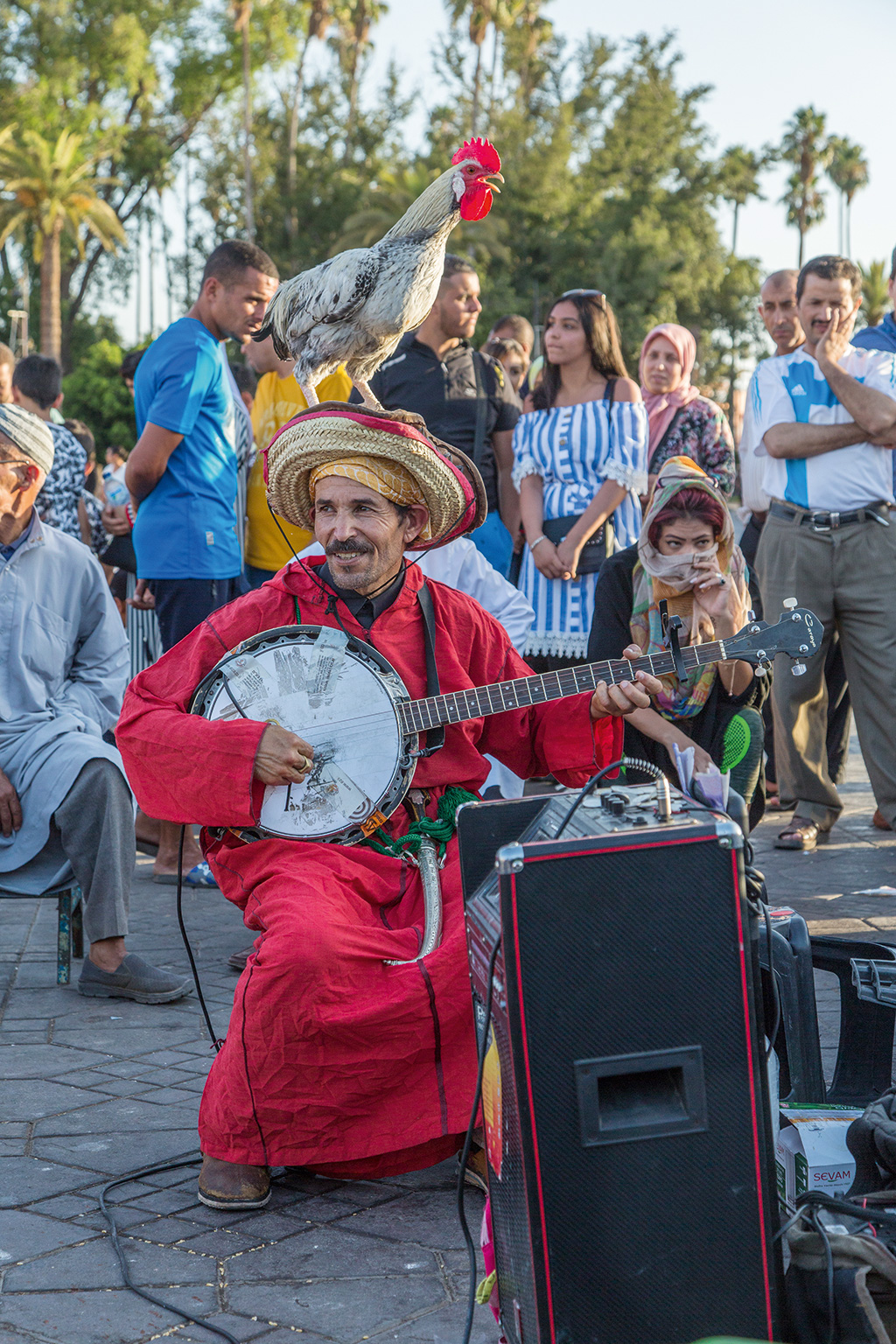
A busker and his rooster entertain passers-by in Djemaa El Fna Square in Marrakech. Image credit: Matthew Sterne
Beyond the food, history and landscapes, Morocco also appeals to travellers for its affordability, political stability and mystical allure. Something Beat writers like Jack Kerouac, Paul Bowles and William Burroughs found out for themselves in the 1950s. They came to this North African country for inspiration, relaxation and to indulge their alternative tendencies. Yes, you might get hassled a little in the markets but most Moroccans we met were gentle and courteous. Of all the Arab countries, Morocco, my fellow travellers assured me, is the most welcoming and easiest to get around in. This has augured well for tourism and Morocco is now the most visited country in Africa, according to the UN World Tourism Organisation, just beating South Africa to first place.
As we neared the end of our trip, I began to realise that every experience was one more piece in the Moroccan mosaic Abdul had been creating for our group. The post-dinner musical performances in the desert, the private spice and argan-oil tours, exploring Todra Gorge and sunset walks in the World Heritage-listed Ait-Ben-Haddou all merged to form one great, dazzling image of Morocco.
Abdul’s combination of colourful turbans, djellabas and shirts meant he brightened up our photos as much as our drives. As the trip proceeded his mischievous side came out too – pretending to be a merchant on the side of the road or making fun of our dazed looks as he intricately described how the city of Meknes was established over a thousand years ago.
Our final stop was the famed city of snake charmers, storytellers and imperial architecture. ‘Marrakech is a melting pot of all Morocco,’ Abdul told us. ‘It’s a happy place. When you get there you see the smiles.’ We spent the afternoon in the famous souks, where there are more than 5 000 stalls selling anything from trumpets and drums to lanterns, paintings, leather bags, carpets, shoes, dresses, olives, daggers, argan oil, herbs and crystals.
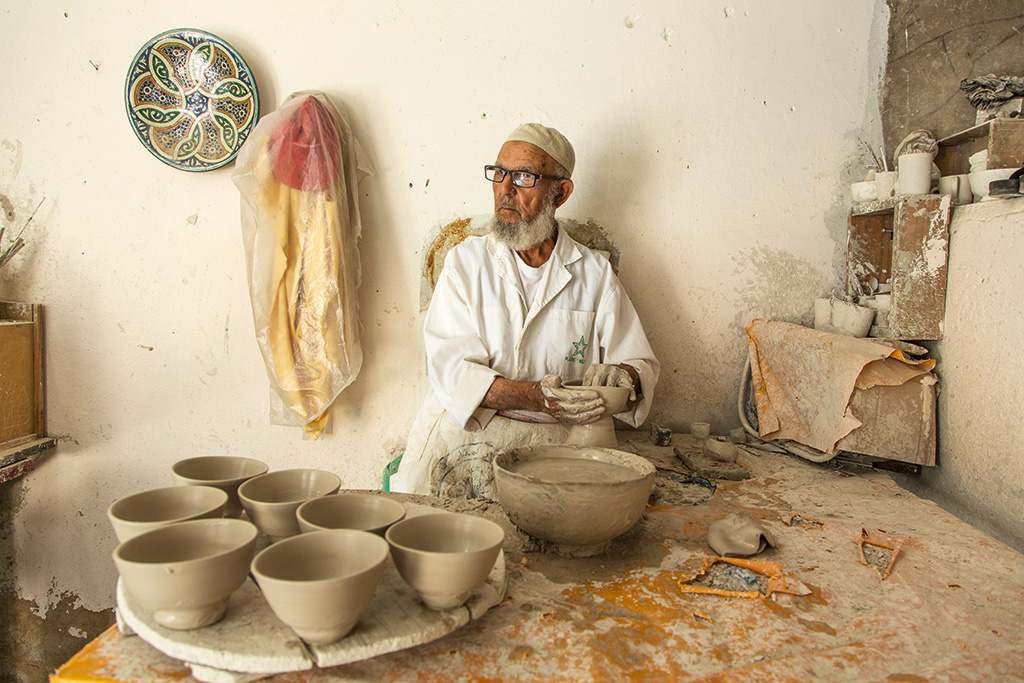
A worker gets his hands dirty at a mosaic factory in Fes. Image credit: Matthew Sterne
As day slipped behind the curtain of night, we found ourselves in Djemaa El Fna Square, the beating heart of Marrakech. The plaza, dating from around 1050 AD, was the site of public executions – hence its name, which translates as ‘Assembly of the Dead’. Food stalls lined the perimeter of the square and everywhere we looked there was action and drama. Crowds gathered in large circles around performers; a snake charmer pretended to lose control of a black cobra and the onlookers scattered. Locals sat in chairs around a Berber band, the singer with a rooster atop his head, while a duo of slapstick comedians drew the largest crowd of all. Henna and juice sellers competed to attract passers-by, while stalls selling river snails had a steady stream of customers.
And there, between the monkeys in Ronaldo and Messi T-shirts and the dancing troupes, was a group of teenage girls trying on VR headsets, laughing hysterically at the reality of their virtual world. A new-age invention among old tricks.
‘You see,’ I said, turning to Abdul, ‘Morocco is …’
He broke out in a proud smile as he replied, ‘… a country of contrasts!’
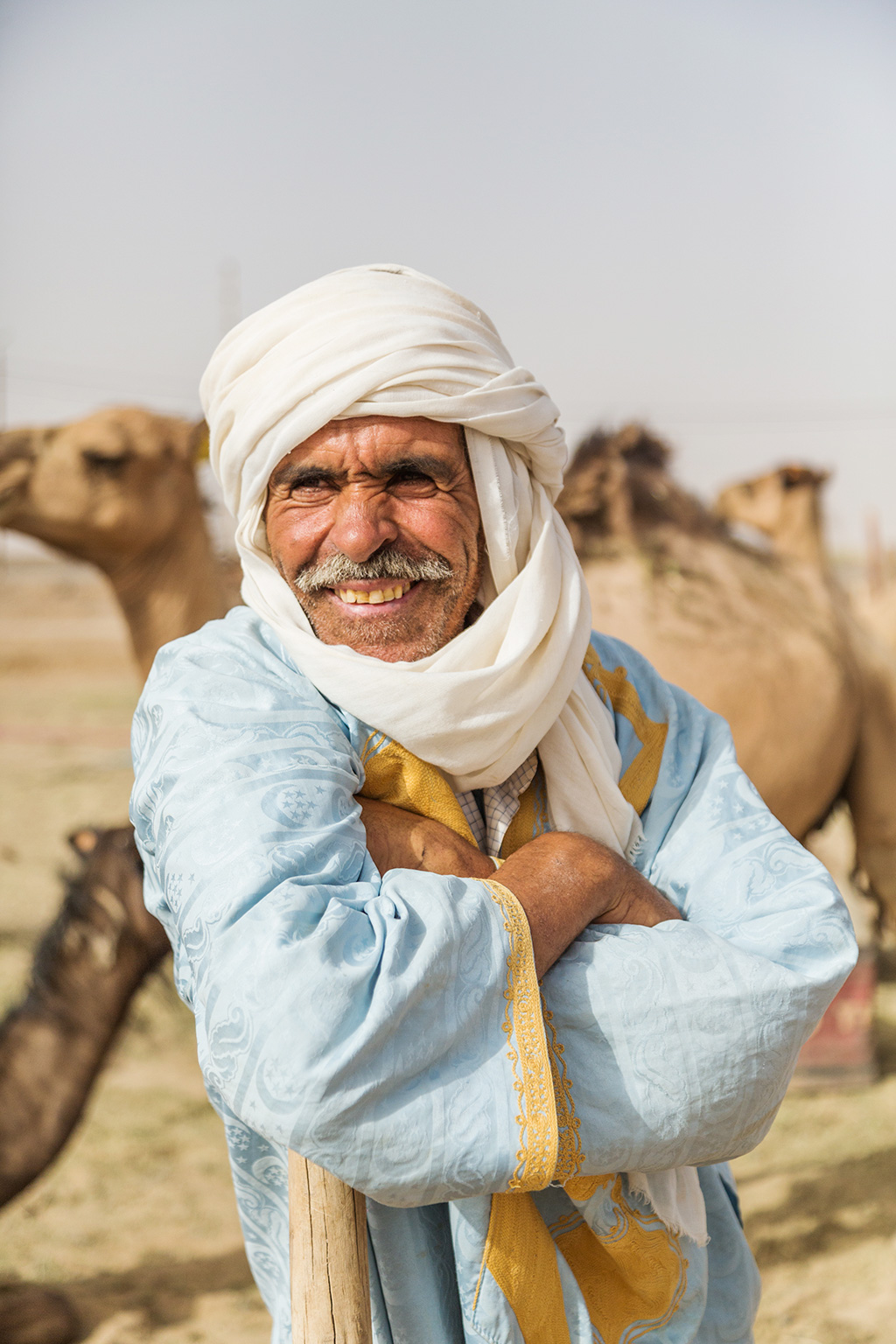
A camel breeder in the Sahara. Image credit: Matthew Sterne

Plan Your Trip
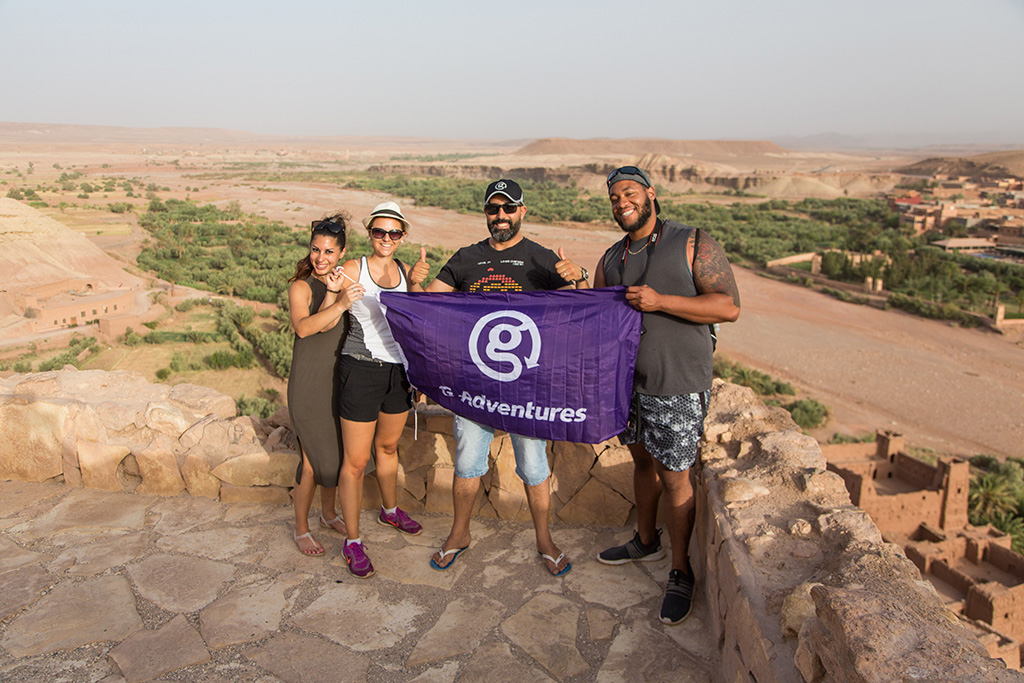
G Adventures Trips
This was the second G Adventures trip I’ve done and I was once again impressed. Groups are never bigger than 14 people, which allows for a certain amount of freedom. Guides are top class too. Abdul El Ghali (behind the flag) was a knowledgeable leader who ensured every step of our way was comfortable and enjoyable. G Adventures sets up small businesses to uplift local communities in every country it operates in – on this trip, we had lunch at an enterprise created to help local women. I chose the eight-day Morocco Kasbahs and Deserts tour, from R9 439 pp. 010-5932-231, gadventures.com
Getting There
Emirates flies daily from Johannesburg to Casablanca via Dubai. Flights start from R8,500. emirates.com

Near the Bab Bou Jeloud Gate within the old city of Fes. Image credit: Matthew Sterne
Need To Know
South Africans need to obtain a visa (R332) before arrival, from the Moroccan Embassy in Pretoria, 012-343-0230. Morocco’s currency is the dirham. One dirham equals R1,50. Meals can cost anything from 35 to 200 dirhams (R54–R310).
Do This
Visit the Hassan II Mosque in Casablanca. The largest mosque in Africa is surely one of its prettiest too, with Atlantic waves crashing at its base and intricate patterns in cedar,
pink granite and marble decorating the spectacular interior. Guided tours cost around R180.
Visit the Roman ruins of Volubilis. The Roman Empire extended well into Morocco more than 2 000 years ago, and at Volubilis you can explore the well laid-out ruins of a former outpost. It’s a fascinating tour of solariums, mosaics of Hercules and sacrificial stones.
City tour of Fes. Follow a local guide through the medina past buildings from the 9th century; there are 350 mosques still in use today. Enter through one of the great gates into the chaos and explore the artisans’ quarters.
Sunset camel ride in the Sahara. This was the highlight of the trip for everyone on our tour. Leaving an hour before sunset, we climbed onto camels and were led by a Tuareg guide into the desert.
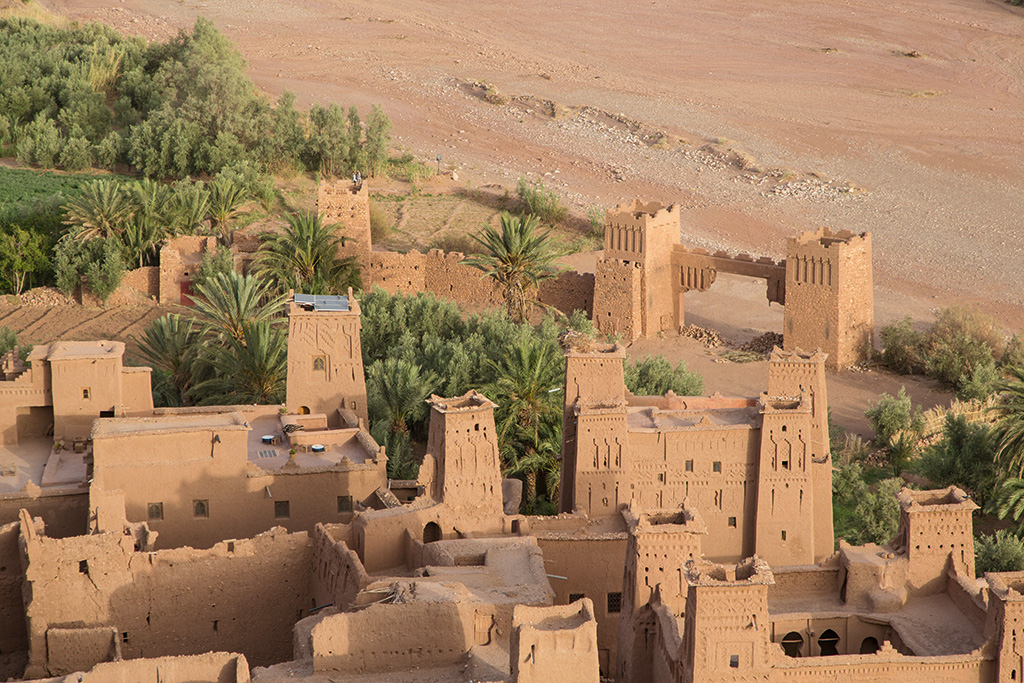
The walled city of Ait-Ben-Haddou was once a stopping point along the caravan route between Marrakech and the Sahara. It’s now a popular film location and a major tourist attraction. Image credit: Matthew Sterne
Merzouga 4×4 desert excursion. The morning after the camel ride we went rally driving in 4x4s, visiting a desert garden, a nomadic family living in the dunes, a kohl mine and a Gnawa band of traditional musicians.
Explore Ait-Ben-Haddou. You may recognise this redmud-brick ksar (Berber fortified village) from film and TV productions such as Gladiator, Babel and Game of Thrones. Of all the remaining kasbahs (citadels) in Morocco, the walls and interior of this abandoned area are the most intact.
City tour of Marrakech. There’s more to this fabled city than the souks and Djemaa El Fna Square. On our tour, we visited the Saadian Tombs, a complex of mausoleums, and the Bahia Palace, built in the late 19th century by the grand vizier of the sultan and intended to be the greatest palace of its time.
Most of the activities listed above are included in the tour.
You may also like
Related Posts
There’s a sublime stretch of coast between the Overberg and main Garden Route mostly bypassed...
read more
The air is thinner at 2 590 metres, not quite elastic enough to contain sound so...
read more
Driving over the Berg River on Carinus Bridge, you’d probably dismiss Velddrif as just another...
read more